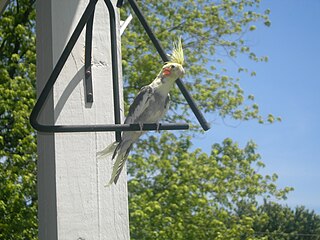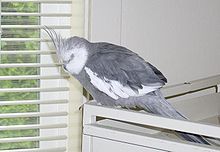
The cockatiel, also known as the weero/weiro or quarrion, is a medium-sized parrot that is a member of its own branch of the cockatoo family endemic to Australia. They are prized as household pets and companion parrots throughout the world and are relatively easy to breed. As a caged bird, cockatiels are second in popularity only to the budgerigar.

The rosy-faced lovebird, also known as the rosy-collared or peach-faced lovebird, is a species of lovebird native to arid regions in southwestern Africa such as the Namib Desert. Loud and constant chirpers, these birds are very social animals and often congregate in small groups in the wild. They eat throughout the day and take frequent baths. Coloration can vary widely among populations. Plumage is identical in males and females. Lovebirds are renowned for their sleep position in which they sit side-by-side and turn their faces in towards each other. Also, females are well noted to tear raw materials into long strips, "twisty-tie" them onto their backs, and fly substantial distances back to make a nest. These birds are common in the pet industry.

The science of budgerigar color genetics deals with the heredity of mutations which cause color variation in the feathers of the species known scientifically as Melopsittacus undulatus. Birds of this species are commonly known by the terms 'budgerigar', or informally just 'budgie'.

The yellow-collared lovebird, also called masked lovebird, black-masked lovebird or eye ring lovebird, is a monotypic species of bird of the lovebird genus in the parrot family Psittaculidae. They are native to Arusha Region of Tanzania and have been introduced to Burundi and Kenya. Although they have been observed in the wild in Puerto Rico, they are probably the result of escaped pets, and no reproduction has been recorded. They have also been observed in Arizona.

The science of rosy-faced lovebird colour genetics deals with the heredity of colour variation in the feathers of the species known as Agapornis roseicollis, commonly known as the rosy-faced lovebird or peach-faced lovebird.

The Blue budgerigar mutation is one of approximately 30 mutations affecting the colour of budgerigars. It is part of the genetic constitution of the following recognised varieties: Skyblue, Cobalt, Mauve and Violet.
The Opaline budgerigar mutation is one of approximately 30 mutations affecting the colour or appearance of budgerigars. It is the underlying mutation of the Opaline variety. When combined with the Yellowface II and Clearwing mutations the Rainbow variety is produced.
The Cinnamon Budgerigar Mutation is one of approximately 30 mutations affecting the colour of budgerigars. It is the underlying mutation of the Cinnamon variety and, with Ino, a constituent mutation of the Lacewing variety.
The Ino budgerigar mutation is one of approximately 30 mutations affecting the colour of budgerigars. It is the underlying mutation of the Albino and Lutino varieties and, with Cinnamon, a constituent mutation of the Lacewing variety.

The Slate budgerigar mutation is one of approximately 30 mutations affecting the colour of budgerigars. It is the underlying mutation of the Slate variety.
The German Fallow budgerigar mutation is one of approximately 30 mutations affecting the colour of budgerigars. At least three types of Fallow, the German, English, and Scottish, all named after their country of origin, have been established, although none of these types is common. They are superficially similar, but adult birds may be distinguished by examining the eye. All have red eyes, but the German Fallow shows the usual white iris ring, the eye of the English Fallow is a solid red with a barely discernible iris and the iris of the Scottish Fallow is pink.
The English Fallow budgerigar mutation is one of approximately 30 mutations affecting the colour of budgerigars. At least three types of Fallow, the German, English and Scottish, all named after their country of origin, have been established, although none of these types is common. They are superficially similar, but adult birds may be distinguished by examining the eye. All have red eyes, but the German Fallow shows the usual white iris ring, the eye of the English Fallow is a solid red with a barely discernible iris and the iris of the Scottish Fallow is pink.
The Clearflight Pied budgerigar mutation is one of approximately 30 mutations affecting the colour of budgerigars. It is the underlying mutation of the Continental Clearflight and Dutch Pied varieties. The Dark-eyed Clear variety results when the Recessive Pied and Clearflight Pied characters are combined.
The Australian Pied budgerigar mutation is one of approximately 30 mutations affecting the colour of budgerigars. It is the underlying mutation of the Banded Pied variety.

In poultry standards, solid white is coloration of plumage in chickens characterized by a uniform pure white color across all feathers, which is not generally associated with depigmentation in any other part of the body.

Albinism is the congenital absence of melanin in an animal or plant resulting in white hair, feathers, scales and skin and reddish pink or blue eyes. Individuals with the condition are referred to as albinos.

The lutino cockatiel is one of the most popular mutations of cockatiel, with white to light-yellow feathers and orange/red cheek patches.

The Pied cockatiel is the first mutation of cockatiel colour genetics, with a mostly grey to light-yellow and white feathers and orange cheek patches.

The normal grey cockatiel, wild type cockatiel, wild cockatiel or grey cockatiel, is the origin cockatiel of all colour genetics mutations, with mostly grey feathers and orange cheek patches.

The white-faced cockatiel is one of the cockatiel colour genetic mutations, with a mostly white or grayish face. They stand out because they have no orange cheek patches or yellow coloring at all. This is the seventh established mutation which appeared for the first time with domesticated cockatiels in 1964 in Holland.



















